Every innovation starts with an idea. But turning raw thoughts into real impact requires more than creativity. It takes structure, collaboration, and the right environment to explore new possibilities. Ideation is the process of generating and developing ideas that solve problems, meet emerging needs, or unlock future opportunities. When done right, it can fuel breakthrough innovations, engage employees and stakeholders, and drive sustainable growth.
Whether you're looking to spark creativity, run ideation workshops, or build a repeatable process for idea generation, this guide gives you the tools and techniques to do it effectively.
Definition: What is ideation?
Ideation is a creative and systematic method for generating valuable ideas and refining them further in a multi-stage process consisting of phases and gates. While the number of ideas decreases over the course of the process, the depth of content increases. Employees, test users, clients, experts, service providers, or external crowds can be involved in corporate ideation sessions.
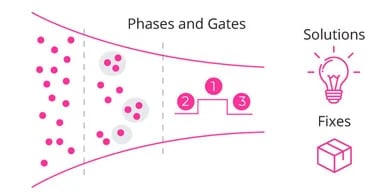
Definition: What is an idea?
An idea is a novel proposal, concept, or solution that addresses an existing challenge or opportunity. Ideas are formed by information connected in new ways and usually are abstract concepts that follow a specific purpose or spontaneous impulse.
A good idea is a network. A specific constellation of neurons—thousands of them—fire in sync with each other for the first time in your brain, and an idea pops into your consciousness.
― Steven Johnson, Where Good Ideas Come From: The Natural History of Innovation
The history of ideation
The first records of ideation come from the 1800s. The verb ideate is recorded earlier, in the 1600s, and derives from the Latin verb "ideare", from the Greek idea, meaning "model," "pattern," or "notion." This is also where the word idea comes from. Ideation can be another way to say thinking, but it’s usually used in a slightly more specific way. Ideation is idea creation—the formation of thoughts and mental images. It’s often used in the context of business development to refer to brainstorming for new products or business opportunities.
Ideation often happens with a larger crowd in order to generate as many and diverse ideas as possible. This practice emerged in the 18th century when the British Parliament asked the population to submit ideas for a method of measuring longitude at sea. Accurate knowledge of longitude and latitude was required to determine a ship’s position at sea and thus ensure safe navigation. With a prize of £20,000 for whoever came up with a solution, a large number of proposals were submitted based on a variety of approaches. Ultimately, from all the ideas submitted, a solution was found that allowed for a more accurate determination of longitude.
Another example is the synthesis of margarine. In 1869, Napoleon III offered a prize to anyone who discovered a process for making a butter substitute for the armed forces and the lower classes. The result was the idea for processed fat, today known as margarine. Both examples show not only the long history of idea generation with a large crowd but also the effectiveness of ideation as a method for innovation development.
Innovation through ideation: A modern approach
Over time, such approaches to solving complex problems have become increasingly valued. In particular, ideation challenges, either in-house or with an external crowd, have gained popularity as a method for generating new ideas and as a source of innovation. Well-known companies such as Adidas, BMW Group, Cisco, or Porsche have already successfully put this into practice.
Difference between ideation and innovation management
In many companies, the terms innovation management, ideation, and idea management are still used synonymously. However, a closer look at the end-to-end innovation management process reveals that there are significant differences.
At ITONICS, we believe that:
- Innovation does not start with ideas - it starts with information.
- Ideation is only one possible component of the innovation process.
Simply collecting ideas is not sufficient in the long run, as a strategic basis with a justified course of action is missing. We divide the innovation process into 3 areas: Where to Play? How to Win? What to Execute? Each of these areas focuses on different activities that together form an end-to-end innovation value chain.
Idea generation is only one step within this end-to-end innovation process. We see ideation as a relevant component in the How to Win stage that translates insights from the environmental scanning activities into targeted idea development. Qualified ideas can develop by considering threats and opportunities relating to environmental scanning insights.
Difference between ideation and idea management
The distinction between ideation and idea management is somewhat more difficult. While ideation generally describes the creative, multi-stage methodology of idea generation, we understand idea management to be more of an operational process in the corporate context for the systematic generation, enrichment, evaluation, and management of ideas in all phases of the innovation process.
- Ideation: Ideation is the stage of the innovation process in which new ideas and concepts are generated using a multi-stage process consisting of phases and gates.
- Idea management: Idea management refers to the structured process of generating, assessing, and improving ideas that contribute to an organization’s innovation strategy. This includes the prioritization and implementation of ideas. Idea management can occur through a centralized or decentralized process. Centralized idea management allows an entire organization to engage in the process, whereas decentralized idea management allows different teams or business units to manage their own ideas.
Why is ideation important in the innovation process?
Generating ideas in collaboration with employees, clients and partners helps to identify and create new products, services, and business models, and harnessing the creative potential of a crowd can be crucial to success. Usually, ideas are explored in answer to a specific question, or as a solution to a certain problem. Often, the ideas generated are based on the wishes or expectations for a product. Involving clients in the ideation process can provide valuable information that results in more robust ideation. By integrating users directly into product development, this information can be gathered better and faster than through conventional methods such as market research or trend scouting, which can result in improved product-market fit solutions.
The key benefits of generating ideas collaboratively are as follows:
- Enable goal-oriented ideation by connecting targeted ideation campaigns to previously identified growth opportunities that are aligned to strategic priorities
- Enrich the ideation process with creativity and external knowledge to spot relevant trends, technologies, and inspirations
- Engage global communities from small teams of experts up to global innovation networks
- Get instant feedback on innovative ideas and concepts from your target group in real-time
- Sustain the motivation by incentive systems, competitions, and gamification
- Set up KPIs, innovation governance, and innovation controlling schemes to maintain focus and ensure resource investments are well managed
- Create an entrepreneurial mindset and innovation culture across your organization
- Strengthen cross-functional collaboration
To ensure that your organization takes advantage of these benefits and maintains world-class ideation, the following challenges must be considered:
- Connecting ideation activities with business opportunities contributing to the overall company strategy
- Creating a collaborative ideation process that connects environmental scanning capabilities with innovation execution
- Selecting and implementing engagement and reward models
- Activating and maintaining the ideation community
- Choosing evaluation methods and criteria
- KPIs, innovation governance, and controlling
Different ideation methods
Ideation finds various fields of application in today's innovation context. As highlighted before, ideas can be generated, for example, at the corporate level with employees, external stakeholders like clients and partners, or from an unknown external crowd. This can happen in a contest setting or in ideation workshops. In this chapter, we will dive deeper into five different approaches to idea generation:
- Closed vs. Open Innovation (Crowdsourcing)
- Design Thinking
- Ideation Workshop
- Ideation Challenge
- Idea Portfolio
Also see: 10 Powerful Ideation Techniques to Unleash Creativity and Innovation
Closed vs. open innovation (crowdsourcing)
Closed innovation
Within the innovation process, you can differentiate between open and closed innovation. Closed innovation describes the conventional approach that innovation is developed exclusively within the company itself. This includes the generation of ideas for products, services, or business models, to concept creation and development.
Open innovation/ crowdsourcing
In order to increase the innovation capabilities within the company and create competitive advantages, opening up the conventional innovation process beyond internal boundaries and integrating the innovation potential of external stakeholders has proven to be a promising approach within the past decade. This is referred to as open innovation. By sourcing knowledge externally, organizations can counteract market uncertainties and the complexity of innovation and knowledge recombination. Open innovation involves a wide range of external actors, including users, customers, suppliers, universities, startups, and competitors. A variety of formats exist for accessing external knowledge, such as competitions and campaigns, corporate venture capital, or open-source platforms.
Generating innovative ideas and solution approaches by an external crowd, usually in the context of an innovation contest, is called crowdsourcing. The crowd can consist of either just a few experts or thousands of ideators. In this way, a broad mass of individuals with a wide range of characteristics and qualifications can be reached and their diverse potential used. To engage and motivate the crowd, the best ideas submitted are rewarded.
Design thinking
Design thinking describes a process for developing new concepts. It is often associated with creative facilitation, but the discipline is much more than creative workshops. It refers to user-centered methods for guiding innovation and an innovation framework that allows non-designers to approach problems like designers. Thanks to its open, flexible, and human-centered nature, design thinking became a popular method for driving innovation. The design thinking process consists of five steps: empathize, define, ideate, prototype, and test.
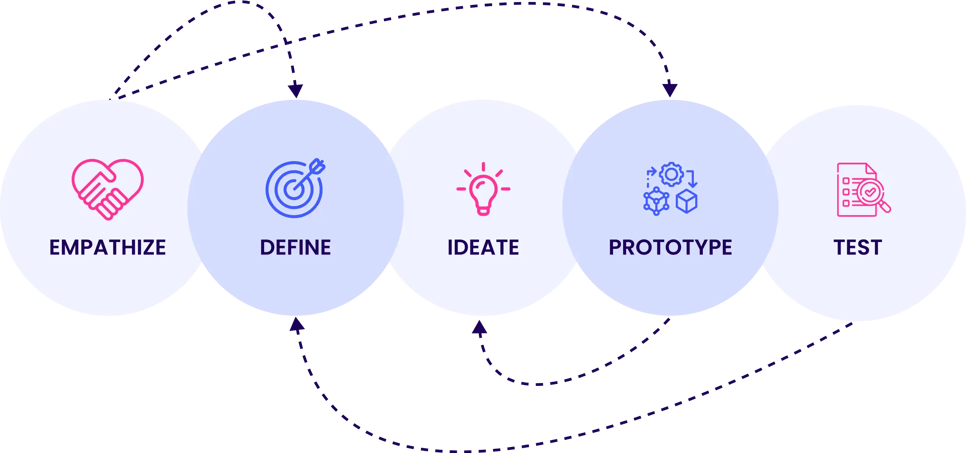
After understanding users' existing problems and defining their needs in the first two steps, the ideation phase involves developing ideas for potential solutions to fix the problem. There are a variety of ideation techniques that can be applied here, such as brainstorming or the Crazy 8’s method. Monitoring trends can be another helpful starting point, as they indicate consumer needs and demands based on observed changes in behavior.
After generating a set of ideas, they are usually prioritized (e.g. in idea portfolios) before the most promising one is prototyped (MVPs - minimum viable products or mockups) and tested with users. This process helps innovators to identify at an early stage of the innovation process whether a product idea has value for users or not.
Ideation workshop
An ideation workshop is a session focused exclusively on the development of new ideas, with the main objective of driving innovation. It usually involves stakeholders from different teams and departments and promotes cross-functional collaboration and innovation. What makes idea workshops special is that they take place in a different environment than the normal workspace to foster creativity.
Once you have defined your problem statement, you can use various ideation techniques to generate a wide range of ideas. Thereby, lateral thinking needs to be encouraged and the focus is on the quantity rather than the quality of ideas. At this stage, it is all about generating as many ideas as possible, regardless of the technical feasibility. Moreover, ideas generated in an ideation session or workshop are not judged, which encourages participants to think outside the box and come up with novel ideas.
To ensure that your ideation workshop is a success, you should follow these steps:
- Invite the right people
- Designate a facilitator
- Choose the right location
- Define the problem
- Select ideation techniques
- Generate ideas and outline next steps
After your ideation workshop, you will have a pool of new ideas. You then need to evaluate which ideas should be further pursued, e.g., in terms of feasibility or impact. The visualization in an idea portfolio is a common method for this.
Ideation challenges
Depending on the context, the ideation challenge can sometimes be referred to as an “idea campaign”, “innovation challenge”, or “ideation contest”. Regardless of the name, ideation challenges are in essence creative activities that involve a fixed or varying number of - either internal or external - participants, contributors, and/or experts coming together to submit innovative ideas on a specific need or problem, evaluating them among themselves and thus filtering out the best winning ideas. Ideation challenges provide an opportunity to focus on specific sub-goals of the innovation strategy.
The setting of an ideation challenge can be either top-down or bottom-up:
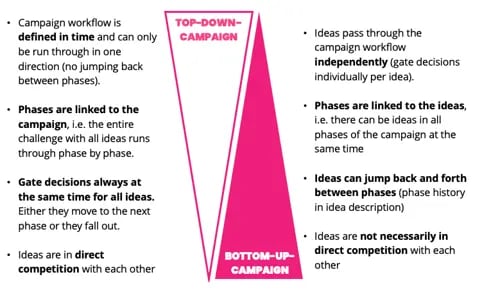
- Top-down challenge (challenge-centric): This campaign type is based on a step-by-step process, where submissions are filtered out from one phase to the next until the best submissions reach the final phase.
- Bottom-up challenge (submission-centric): All phases of this campaign type are active at the same time and submissions can evolve and can be moved in every phase available.
Idea portfolio
Idea portfolios are used to evaluate generated ideas and prioritize the most relevant ones for achieving strategic goals. In an idea portfolio, two variables are determined according to which the ideas are arranged in a portfolio or diagram. The method can balance different needs since two variables are used. Due to its analytical nature, the method allows for quick but reliable sorting of ideas. In addition, it also helps make informed decisions and even provides a strategic view of options.
Usually, those idea portfolios are used in a workshop setting with appropriate experts to evaluate generated ideas. First, the criteria for ranking the ideas must be defined. These can be, for example, the "value that the implementation of the idea has for the user/customer" and the "effort to bring the idea to life" (Source: This is Service Design Doing). Next, a portfolio (diagram) is created with both axes labeled either remotely on a wall, virtually on a whiteboard, or by using software.
Finally, the ideas previously generated and written down are evaluated according to the criteria and arranged on the diagram. You now have an overview of all the ideas and can decide which ones to invest in further. Usually, the most interesting ideas at the beginning are the "low-hanging fruits", i.e. the ideas with high value and low implementation effort.
Ideation process steps
A proper ideation process can help you to find answers to some very important questions within your innovation journey:
- Which strategic innovation fields are necessary for new products and services?
- How do I set up targeted ideation campaigns and who should contribute?
- How do I transform ideas into concepts, products, and solutions?
In the following, we present a simple process of an ideation challenge:
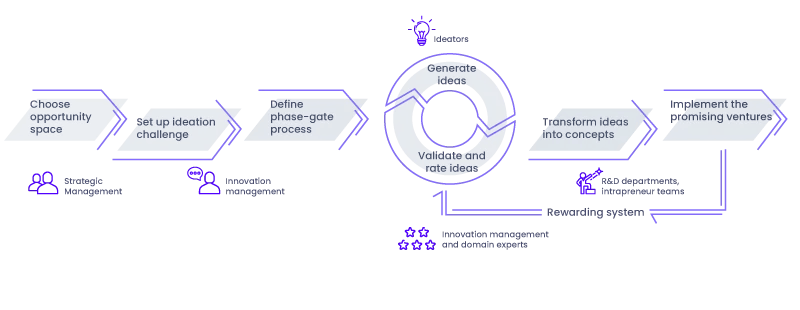
1. Choose a challenge or opportunity space
- You should be able to answer a basic but critical question first: Where do we want to ideate, innovate, and grow? Those opportunity spaces define the areas in which future growth is possible or even necessary, and are the starting point for any ideation process.
- Direction is usually set "top-down", i.e. employees are invited to submit creative solution proposals for a particular problem defined by the company management or strategy departments.
- By setting a clear search direction for your challenge, participants can move to the desired outcome more quickly.
- By giving your participants a framework with a well-defined timeline, ideation projects become predictable and powerful new resources within the innovation process.
2. Set up an ideation challenge
- The problem that should be solved has to be defined with the right balance between depth and generalism.
- The definition of the problem or question posed to the innovation community should be done by a small group of people.
- The question should be framed in positive language to inspire responses.
- To nurture a solution-driven approach, “How might we…”-phrased questions are often used.
- The platform or format where ideas should be generated has to be determined and whether to include only internal stakeholders or external ones (Open vs. Closed innovation).
- To steer the generated ideas into the right direction, a framework for the ideas and a lens or context should be included.
- The expectations and information required from participants should be clearly defined.
- Each campaign should be managed through a domain expert.
3. Define phase-gate process
- It has to be determined how many phases or stages (e.g. Inspire, Ideate, Review, Implement) submitted ideas should run through.
- The criteria that submitted ideas need to fulfill at each stage have to be defined.
4. Generate and validate ideas
- Moderators are useful to engage idea development and rating within the innovation community.
- Experts should be assigned who are able to validate and rate submitted ideas, e.g. by time-to-market, need for action, implementation risk, internal know-how, or development costs.
5. Transform ideas into concepts
- The opportunity-rich ideas need to be further evaluated and developed.
- Concepts need to be tested and validated with users.
6. Implement the promising ventures
- Promising concepts receive further necessary (financial) support and are implemented by R&D departments or intrapreneurial teams as part of product development.
7. Reward and recognize
- The idea owners and implementers are rewarded in monetary or non-monetary form. Examples include financial support, involvement in product development and testing, visibility, and recognition within the company.
- This can also be done at an earlier stage of the process (after evaluation of the best ideas and before implementation).
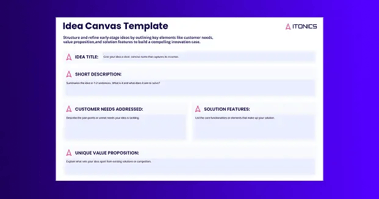
Idea Canvas Template

How to Rate Ideas
Most important ideation stakeholders
For your ideation activities to be a success, an organization must define the key stakeholders and what you expect from them. For example, large companies need to decide whether all company employees should be invited to participate, regardless of their function, or whether participation should be limited to specific departments or functions when developing ideas on a particular issue. In addition, stakeholders are relevant depending on whether idea generation takes place internally or externally.
When considering internal ideation challenges or workshops on a corporate level, the following functions need to be included based on the ideation phase process:
- Strategic Management: to choose opportunity spaces
- Innovation Management: to manage the campaign/ challenge in all its phases
- Experts: to moderate the challenge and to validate and rate the ideas
- Ideators: to generate ideas (source of knowledge)
- Intrapreneur Teams: to turn ideas into feasible business concepts
- R&D Departments: to work with Intrapreneur teams and implement promising ideas that have been translated into viable/feasible business concepts
- Top Management: to validate and rate the winning ideas in order to gain commitment for such innovation activities already at an early stage
When opening up the ideation process to external stakeholders, the following sources of knowledge can become relevant:
- Partners: to bring external perspectives into a company’s innovation ecosystem
- Clients: to systematically collect feedback and test drive (fail fast) new concepts and prototypes
- Students: to bring innovative thinking and young talent into a company
- Scientific Institutions: to ensure a critical perspective and a well-founded analysis of new inventions
- Service Providers: to establish a digital and collaborative infrastructure
- Expert Communities: to access needed skills and knowledge
- Startups: to leverage new technologies and disruptive approaches
More about how to gain management commitment for strategic innovation activities and how to communicate them effectively to relevant stakeholders:
How to measure ideation success
Any innovation activities will be wiped out relatively quickly if they do not generate measurable outputs. Management in particular will soon demand meaningful numbers, which is why you should start thinking about the strategic direction of your activities early on. This is just as true - or especially true - for idea management. If the strategic basis is missing, your ideas will almost certainly lead nowhere and you will quickly lose the interest and commitment of the management. However, this can be prevented at an early stage.
Financial impacts unfold only in the future, so justifying and aligning innovation activities with desired future goals requires a special kind of metrics: actionable innovation metrics.
Actionable innovation metrics must be relative (input/output) and time-bound to identify actual progress. They should relate to specific goals that provide direction for innovation activities. Based on these characteristics, actionable KPIs indicate possible directions for change. This means either taking action to increase participant engagement or to improve process efficiency and effectiveness.
Ideation engagement KPIs can include:
Metrics that help to assess the motivation and participation of people to contribute to ideation challenges
- % of employees participated
- # of submitted ideas
- # of contributors
- # of comments
- Likes
- Engagement rate
Ideation efficiency and effectiveness KPIs can include:
Metrics that help to assess how well ideas transform into innovations and whether the right ideas are selected
- Time-to-innovation
- Idea-to-innovation ratio
- Idea-to-margin ratio
How software and AI can support your ideation process
Using software for idea generation helps organizations to manage the whole ideation process and bring relevant stakeholders together on one platform.
At ITONICS, we have developed an integrated framework including process, methodology, software support, and best practices in various industries to help clients establish a successful idea management function within the front end of innovation. ITONICS Ideation is a GenAI-driven innovation platform for running all ideation activities such as campaigns (ideation challenges), phase-gate, collaborative evaluations, gamification, portfolio management, etc. With this tool, innovation departments can kickstart ideation challenges with a minimum of effort to spark disruptive ideas and new business models.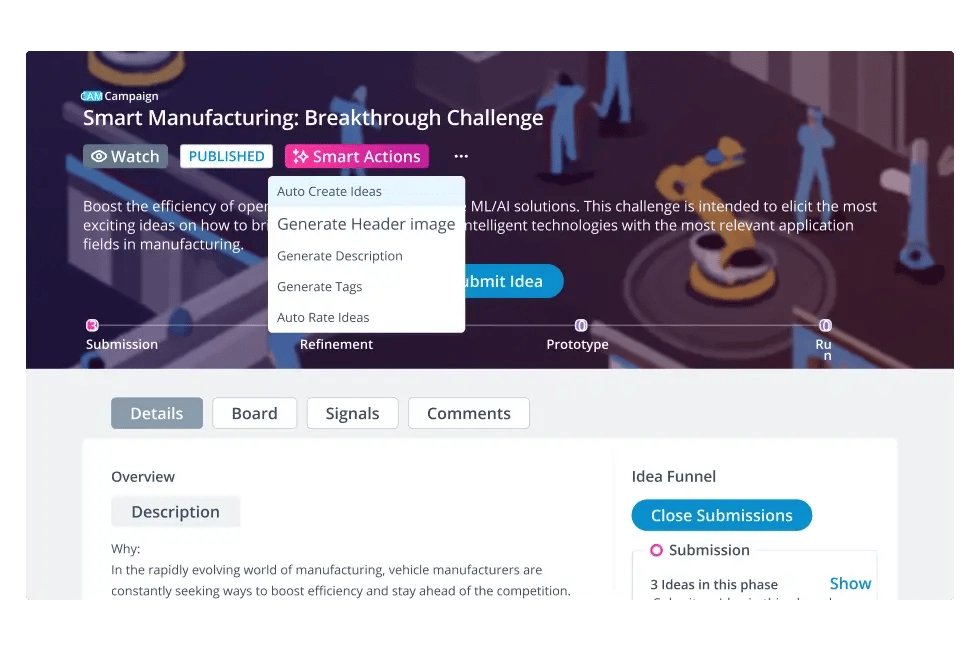
With our ideation software we provide:
- Identification of opportunity spaces: Emerging trends and technologies on the platform help identify strategically relevant opportunity spaces as a starting point for ideation.
- GenAI-driven features: Use the power of GenAI to accelerate idea submissions and automate ratings in phase-gate processes.
- Time-bound and always-on ideation challenges: Manage campaigns in a time-boxed format (top-down) or as always-on campaigns (bottom-up).
- Campaign blueprints: Store and reuse campaign blueprints for the most effective formats (hackathons, idea sprints, e.g.)
- Customizable phase-gate process: Aggregate information sequentially through the implementation of phase-gate workflows.
- Context creation: Link related trends, technologies and inspirations to familiarize users with the concept of your challenges.
- Team functions: Spark ideas and team up to submit innovative concepts to the digital platform. Rate and discuss submissions collaboratively.
- Open and closed innovation: Engage colleagues, customers and partners from different knowledge areas within your digital platform.
- Incentives and reward systems: Encourage a consistent, high level of participation through gamification and incentives.
- Digital community areas and engagement: Build, engage, moderate and manage digital communities to foster collaboration, knowledge sharing and the development of new, innovative solutions.
- Ongoing communication: Ramp up your challenges by sending out executive emails, regular newsletters, reminders or motivators to your innovation community.
- Dynamic campaign visualization: Visualize challenge data and results with different dynamic view options (e.g. idea portfolio, idea radar).
- Powerful and dynamic dashboards: Use built-in reporting tools with numerous visual evaluations for managing and controlling important KPIs of your challenges, as well as your entire innovation management platform.
- After-campaign reports: Export the results of your ideation challenges (e.g. metrics around teams, solutions, participants, coaches) to spread your experiences and lessons learned within your company and the public.
- Tailored to your language, CI, process, and culture: Individual branding, information objects, workflows, and processes make it possible to maximize consistency with your current and future activities.
- Idea portfolios: Evaluate in idea portfolios which ideas to further pursue using ITONICS Portfolio.
Best practices of corporate ideation
The KPMG Global Generative AI Innovation Challenge
Recognizing the immense potential of GenAI throughout the entire innovation process, KPMG created a Global Generative AI Innovation Challenge. Co-sponsored by ITONICS, this challenge aimed to conceptualize how GenAI can improve the innovation lifecycle.
The KPMG innovation challenge was extended to more than 10,000 innovators within KPMG’s global community across 100 countries. GenAI was both the subject of innovation as well as an enabler. KPMG used GenAI to generate the challenge description, provide initial seed ideas, and evaluate submissions alongside the input from its global network.
The Cisco Innovate Everywhere Challenge
In 2015, Cisco launched its first and unique company-wide Innovate Everywhere Challenge. The goal was to drive global disruptive thinking, capture breakthrough innovation opportunities from Cisco employees, help them grow, and improve employee empowerment and collaboration across all functions. As a result, half of all Cisco employees, 36,600 experts, participated in the challenge, submitting a total of about 770 ideas. By collecting ideas specifically for key markets relevant to the company, new technologies, and business models, the resulting projects paid targeted dividends to the company's strategic development.
The Innovate Everywhere Challenge is powered by ITONICS collaborative innovation software and is now a best practice for innovation management at Cisco. The innovation program was awarded the Innovation Leader's Impact 2018 Award.
Create your own success story and discover how the ITONICS software solution can support your ideation activities.
FAQs on ideation
What is ideation in innovation?
Ideation is a creative and systematic method for generating valuable ideas and refining them further in a multi-stage process consisting of phases and gates. While the number of ideas decreases over the course of the process, the depth of content increases. Employees, test users, clients, experts, service providers, or external crowds can be involved in corporate ideation sessions.
What is an idea?
An idea is a thought, suggestion, or concept that offers a potential solution to a problem, a new way of doing something, or an opportunity for improvement. In the context of innovation, ideas are the starting point for creating value, whether through new products, services, processes, or business models. Effective ideation helps capture, shape, and evaluate these ideas to turn them into actionable outcomes.
Why is ideation important in the innovation process?
Ideation is essential for unlocking creative potential and identifying valuable opportunities. It encourages team collaboration, surfaces diverse perspectives, and ensures a steady flow of ideas to fuel innovation pipelines.
How do you run a successful ideation process?
A successful ideation process involves setting clear goals, engaging the right participants, using brainstorming or design thinking techniques, capturing ideas in a centralized platform, and evaluating them against strategic criteria. Software like ITONICS Ideation can support and scale this process.
What are the best methods for generating ideas?
Popular ideation methods include brainstorming, SCAMPER, design thinking, brainwriting, mind mapping, and innovation challenges. Using a combination of techniques helps ensure both creativity and focus.
How can idea management software help with ideation?
Idea management software helps you collect, organize, evaluate, and prioritize ideas efficiently. Platforms like ITONICS allow teams to run structured ideation campaigns, collaborate in real time, and align ideas with strategic goals, turning ideation into measurable outcomes.
How can companies automate the collection and evaluation of ideas?
Companies can automate ideation by using platforms like ITONICS, which support AI-assisted idea generation, automated rating in stage-gate workflows, and customizable evaluation criteria. This leads to better streamlining the intake, triage, and selection of high-potential ideas at scale.



